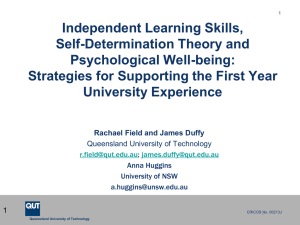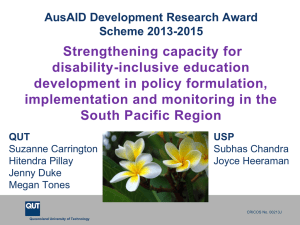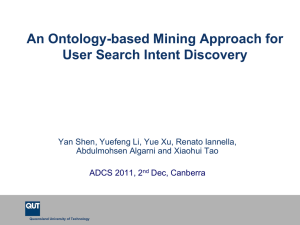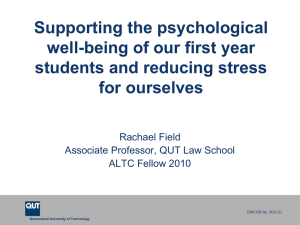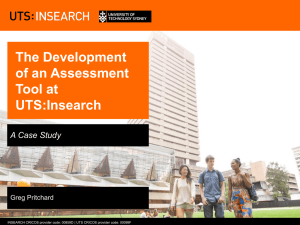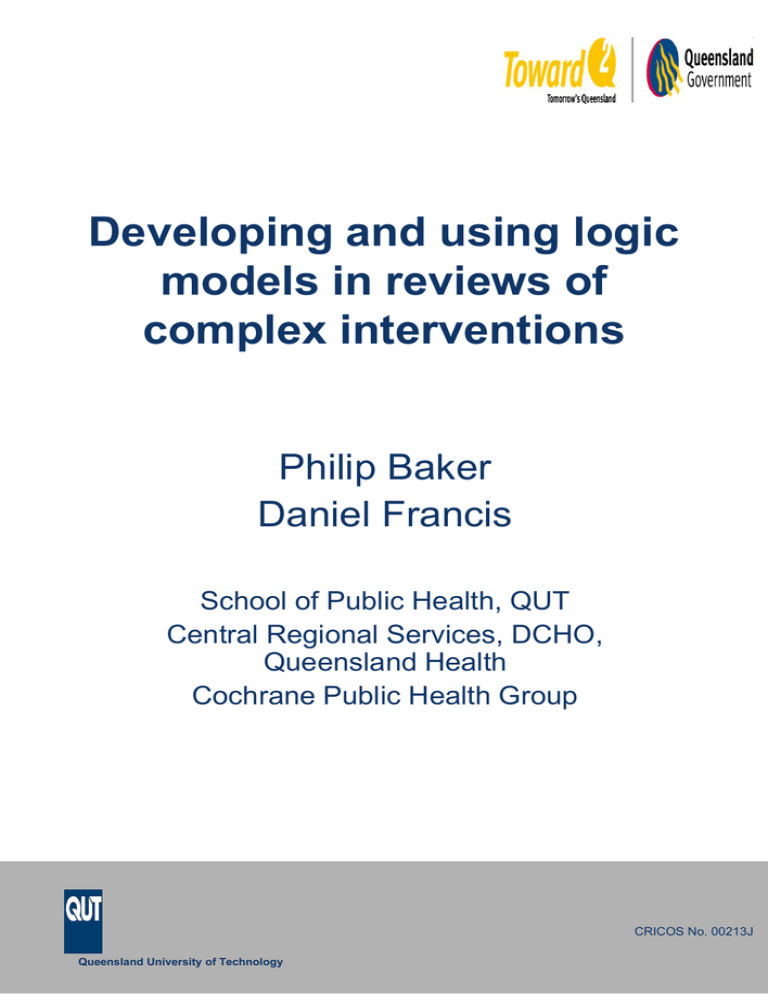
Developing and using logic
models in reviews of
complex interventions
Philip Baker
Daniel Francis
School of Public Health, QUT
Central Regional Services, DCHO,
Queensland Health
Cochrane Public Health Group
CRICOS No. 00213J
Queensland University of Technology
Acknowledgements
Laurie Anderson
Erin Ueffing
Eva Rehfuess
Mark Petticrew
Rebecca Armstrong
Peter Tugwell
Anderson L, Petticrew M, Rehfuess E, et al (2011). Using
logic models to capture complexity in systematic reviews
Research Synthesis Methods, 2011. Published Online.
R
realworld
a university for the
CRICOS No. 00213J
Outline
• What are logic models?
• Why logic models?
• Recent use in Cochrane
Reviews
• Examples in SRs
• Conclusions
R
realworld
a university for the
CRICOS No. 00213J
What are logic models?
Logic model, analytic
framework,
conceptual
framework, concept
map, influence
diagram…
R
realworld
a university for the
CRICOS No. 00213J
Logic model
• Logic model is a…
– Picture of a program or intervention
– Graphic representation
– Useful of planning and evaluation
“If you don’t know
where you are going,
how are you gonna’
know when you get
there?”
Yogi Berra
R
realworld
a university for the
CRICOS No. 00213J
In its simplest form….
INPUTS
OUTPUTS
R
realworld
a university for the
OUTCOMES
CRICOS No. 00213J
Everyday example
Eat food
H
U
N
G
R
Y
Get food
R
realworld
a university for the
Feel
better
CRICOS No. 00213J
Why logic models?
• Make explicit hypothesized links
between determinants of health and
health outcomes
• Examine theoretical plausibility and
mechanisms of action of an intervention
• Identify key effect mediators or
moderators
• Specify intermediate outcomes and
potential harms, including differential
effects among population subgroups
R
realworld
a university for the
CRICOS No. 00213J
Where to get content to put into the logic
model?
• Social and behavioral theory
• Empirical research
• Social and epidemiologic data
• Program evaluation data
R
realworld
a university for the
CRICOS No. 00213J
Logic models can help:
Refine review question
Identify relevant intervention components
Decide on lumping or splitting a review
Identify necessary bodies of evidence:
PICO
Guiding literature search strategy
Justify subgroup analyses (e.g. sex/gender,
SES)
Explain rationale behind surrogate
outcomes used
Interpret results based on intervention
theory and systems thinking
Illustrate how harms, feasibility, and cost
issues are connected with interventions
R
realworld
a university for the
CRICOS No. 00213J
The use of Logic Models in
Cochrane Published Reviews and
Protocols (in 2 Groups)
Cochrane Effective Practice &
Organisation of Care Group:
• None yet into reviews
• 3 of 44 protocols (first appearance
2009);
Cochrane Public Health Group:
• 1 of 3 Reviews (first appearance
2011)
• 5 of 7 protocols
R
realworld
a university for the
CRICOS No. 00213J
Examples
R
realworld
a university for the
CRICOS No. 00213J
Capturing complexity – seeing the big
picture
Food Supply and Population Health
Modifiable Determinants
Intervention
Opportunities
Intermediate Outcomes
Food Supply Factors
Population Food Intake
Agricultural policies
Nutrition policies
Science & technology
Food production,
processing, storage, &
distribution
Food fortification
Food safety
Food Consumption Patterns
(e.g. fruits, vegetables)
Intake of Nutrients and Food
Components
Vitamins
Minerals
Fiber
Fats
Other food
constituents
Dietary supplements
Alcohol
Energy balance
Environmental Factors
Availability & price of food
Neighborhoods
Schools
Worksites
Homes
Local, state & national food
assistance programs
Life Stage
Requirements
Household resources
Nutrition knowledge
Cultural practices
Psychological
characteristics
Advertising and marketing
Taste and preferences
Physical
Activity
R
Patterns
realworld
a university for the
Growth
Adiposity
Musculoskeletal
Gastrointestinal
Metabolic
Cardiovascular
Reproductive
Immunological
Neurological
Health
Outcomes
Morbidity
Mortality
Measures of Health &
Fitness
Pregnancy
Lactation
Childhood
Adolescence
Adulthood
Older adulthood
Consumer Demand
Physiologic Indicators
Genetics
&
Co-morbidities
CRICOS No. 00213J
Source: Anderson LM, Popkin B, Fielding J, Willett W, Picciano MF. 2004 Guide to Community
Capturing key review questions
Source: Harris RP et al. Am J Prev Med 2001;20(3 Suppl):21-35.
R
realworld
a university for the
CRICOS No. 00213J
Capturing complexity – key intervention strategies
Ref: Baker PRA, Francis DP, Soares J, Weightman AL, Foster C.
Community wide interventions for increasing physical activity.
Cochrane Database of Systematic Reviews 2011, Issue 4. Art.
No.: CD008366. DOI: 10.1002/14651858.CD008366.pub2
R
realworld
a university for the
CRICOS No. 00213J
Capturing complexity – key intervention strategies
R
realworld
a university for the
CRICOS No. 00213J
In our Cochrane review….
• Refined the question
• Show stages: development /
implementation
• Definition - components of the
intervention
• Literature search terms
• Classification of interventions and
interpretation
• Data extraction
• Assessment of intensity
Ref: Baker PRA, Francis DP, Soares J, Weightman AL, Foster C.
Community wide interventions for increasing physical activity. Cochrane
Database of Systematic Reviews 2011, Issue 4. Art. No.: CD008366. DOI:
10.1002/14651858.CD008366.pub2
R
realworld
a university for the
CRICOS No. 00213J
Summary
•
•
•
•
•
Sensible
Visually explain relationships
Improve usefulness of review
Are increasing in reviews
Require additional skills, time and
understanding
R
realworld
a university for the
CRICOS No. 00213J
Further information/reading on logic
models
Training
Erin Ueffing (Erin.Ueffing@uottawa.ca), Education Coordinator, Canadian
Cochrane Centre
Systematic reviews
Anderson L, Petticrew M, Rehfuess E, et al (2011). Using logic models to
capture complexity in systematic reviews Research Synthesis Methods,
2011. Published Online.
Concept
Harris RP, Helfand M, Woolf S, et al (2001). Current methods of the U.S.
Preventive Services Task Force. American Journal of Preventive Medicine
20(3S):21-35.
Joffe M & Mindell J (2006). Complex causal process diagrams for analyzing the
health impacts of policy interventions. American Journal of Public Health
96(3):473-479.
Application
Baxter S, Killoran A, Kelly MP & Goyder E (2010). Synthesizing diverse
evidence: the use of primary qualitative data analysis methods and logic
models in public health reviews. Public Health 124:99-106.
Equity
Tugwell P, Petticrew M, Kritjansson E, et al (2010). Assessing equity in
systematic reviews: realising the recommendations of the Commission on
Social Determinants of Health BMJ 341:c4739
R
realworld
a university for the
CRICOS No. 00213J

